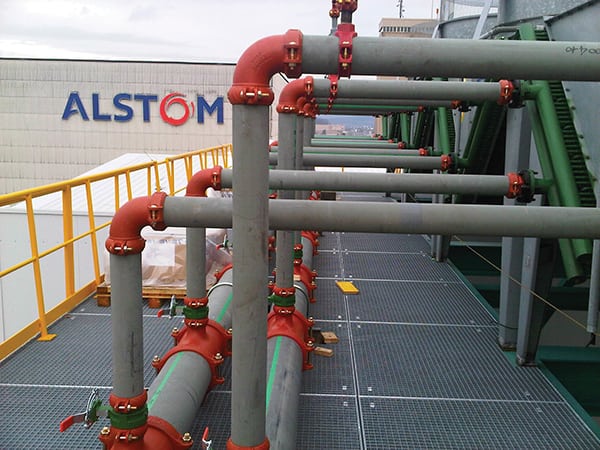Minimizing welding allows certified welders to focus on critical process systems while pipefitters handle the balance-of-plant systems, which can contribute to on-time completion of a project. Grooving pipe and assembling couplings do not require specialized certifications or training; the processes are easily taught and transferred.
These benefits were leveraged during construction of the South Hedland Power Station, located in the Pilbara region of Western Australia (Figure 5). With rapid growth requiring significant investment in power projects, the Horizon Power–owned facility chose grooved products due to a tight timeline and remote location. Selected for diesel fuel, raw/fire water, demineralized water, drinking water, and instrument air systems, grooved piping resulted in a fast, safe installation that eliminated the need for hot work and eased on-site pipe-end fabrication.
 |
| 5. A safe solution for many power plant systems. Grooved piping was used on several water, air, and diesel fuel systems at the South Hedland Power Station in Western Australia. Courtesy: Victaulic |
The safety advantages of grooved piping are complemented by the speed and ease of system installation. Standard grooved couplings can be installed up to five times faster than welded joints and three times faster than flanged joints. Ready-to-install couplings can double the time savings. Special tools are not required to assemble a grooved coupling, and most couplings do not have torque requirements. In addition, grooved systems provide visual confirmation of proper assembly.
Speed and ease of installation were instrumental during the construction of an Alstom gas-fired test facility in Birr, Switzerland (Figure 6). By joining the cooling and fire water piping systems with grooved couplings, valves, and fittings, Alstom was able to reduce installation hours 50% compared to traditional joining methods, resulting in considerable cost savings and faster project completion. The grooved components will also enable easy access for maintenance and repair.
 |
| 6. Installing grooved piping can save time. Alstom installed grooved piping at a facility in Switzerland, cutting installation time in half compared to welding. Courtesy: Victaulic |
Grooved couplings reduce maintenance downtime and, with a union at every joint, simplify system access, if needed. Couplings are easily disassembled and removed from the joint. Following completion of work, the coupling can be reassembled as quickly as initial installation. This characteristic eases maintenance, repair, and future expansions or modifications. When properly installed and operated within design specifications, grooved mechanical couplings are designed to last the life of the system and will not leak or fail.
Grooved systems bring a number of advantages to construction and upgrade projects, from quick, flame-free installation to simplified maintenance. Most importantly, grooved mechanical piping offers plant owners a means of speeding project completion while maintaining a safe environment. ■
—Mitch Lee is a business development specialist for the power market with Victaulic, a manufacturer of mechanical pipe-joining and fire protection systems. He is also a member of the Construction Industry Institute.
